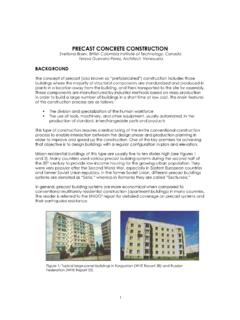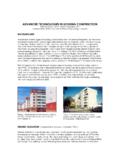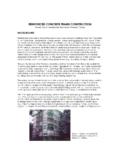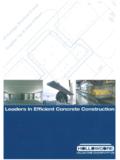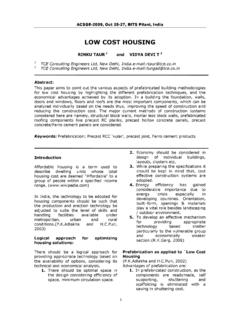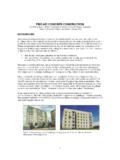Transcription of HOUSING REPORT Buildings with hollow clay tile …
1 World HOUSING Encyclopedia an Encyclopedia of HOUSING Construction in Seismically Active Areas of the World an initiative of Earthquake Engineering Research Institute (EERI) and International Association for Earthquake Engineering (IAEE) HOUSING REPORT Buildings with hollow clay tile load-bearing wallsand precast concrete floor slabsReport #34 REPORT Date05-06-2002 CountryKYRGYZSTANH ousing TypeUnreinforced Masonry BuildingHousing Sub-TypeUnreinforced Masonry building : Brick masonry in lime/cement mortarAuthor(s)Ulugbek T. Begaliev, Svetlana UranovaReviewer(s)Svetlana N. BrzevImportant This encyclopedia contains information contributed by various earthquake engineering professionalsaround the world. All opinions, findings, conclusions & recommendations expressed herein are those of thevarious participants, and do not necessarily reflect the views of the Earthquake Engineering ResearchInstitute, the International Association for Earthquake Engineering, the Engineering InformationFoundation, John A.
2 Martin & Associates, Inc. or the participants' of this type are characterized with load-bearing masonry walls and precast concretefloors. Typical Buildings of this type are 3 to 4 stories high and they are characterized with twolongitudinal walls and several cross walls. There are many existing Buildings of this type inKyrgyzstan, and most of them were constructed in the 1960s. This construction practice wasbanned after 1966, due to the code provisions that required restriction of the size of the coresin hollow clay tiles (blocks). The exterior walls are made of hollow clay masonry tiles (blocks).In some cases there are two wall wythes: the exterior wythe made of hollow clay tiles and theinterior wythe made of solid clay bricks.
3 The floor system consists of precast reinforcedconcrete hollow core slabs. Buildings of this type were built in the areas with high seismicdesign intensity (8, 9 and higher on the MSK scale). This building type is considered to berather vulnerable to seismic effects. 1. General InformationBuildings of this construction type can be found in large parts of Kyrgyzstan: Most of them are located in urbanareas. This type of HOUSING construction is commonly found in urban areas. This construction type has been inpractice for less than 75 , this type of construction is not being built.. Figure 1: Typical building Figure 2A: Key Load-Bearing Elements Figure 2B: A typical hollow clay tile (block)dimensions2. Architectural Siting These Buildings are typically found in flat terrain.
4 They do not share common walls with adjacent Buildings . Whenseparated from adjacent Buildings , the typical distance from a neighboring building is 10 meters. building Configuration Typical shape of a building plan for this HOUSING type is rectangular. Typical window size is m X m. Typicaldoor size is m (width) X m (height). The overall window and door area accounts for 10 to 12% of the overallwall surface area. Functional Planning The main function of this building typology is multi-family HOUSING . In a typical building of this type, there are noelevators and 1-2 fire-protected exit staircases. There is one staircase in each building unit. building unit consists of 4apartments ( HOUSING units) on each floor.
5 Each building consists of 2 to 4 building units. Modification to building There are lot of modifications at the ground floor level in Buildings of this type. Typical modifications includeinstallation of new door and windows openings, complete/partial removal of existing walls, and horizontal extension(addition of rooms). Figure 3: Plan of a Typical building 3. Structural Structural System MaterialType of Load-Bearing Structure#SubtypesMost appropriate typeMasonryStone Masonry Walls1 Rubble stone (field stone) in mud/lime mortar or without mortar (usually with timber roof) 2 Dressed stone masonry (inlime/cement mortar) Adobe/ Earthen Walls3 Mud walls 4 Mud walls with horizontal wood elements 5 Adobe block walls 6 Rammed earth/Pise construction Unreinforced masonrywalls7 Brick masonry in mud/limemortar 8 Brick masonry in mud/limemortar with vertical posts 9 Brick masonry in lime/cementmortar 10 Concrete block masonry incement mortar Confined masonry11 clay brick/tile masonry, withwooden posts and beams 12 clay brick masonry, withconcrete posts/tie columnsand beams 13 Concrete blocks, tie columnsand beams Reinforced masonry14 Stone masonry in cementmortar 15 clay brick masonry in cementmortar 16 Concrete block masonry incement mortar Structural concreteMoment resistingframe17 Flat slab structure 18 Designed for gravity loadsonly.
6 with URM infill walls 19 Designed for seismic effects, with URM infill walls 20 Designed for seismic effects, with structural infill walls 21 Dual system Frame withshear wall Structural wall22 Moment frame with in-situshear walls 23 Moment frame with precastshear walls precast concrete24 Moment frame 25 Prestressed moment framewith shear walls 26 Large panel precast walls 27 Shear wall structure withwalls cast -in-situ 28 Shear wall structure withprecast wall panel structure SteelMoment-resistingframe29 with brick masonry partitions 30 with cast in-situ concretewalls 31 with lightweight partitions Braced frame32 Concentric connections in allpanels 33 Eccentric connections in afew panels Structural wall34 Bolted plate 35 Welded plate TimberLoad-bearing timberframe36 Thatch 37 Walls with bamboo/reed meshand post (Wattle)
7 And Daub) 38 Masonry with horizontalbeams/planks at intermediatelevels 39 Post and beam frame (nospecial connections) 40 Wood frame ( with specialconnections) 41 Stud-wall frame withplywood/gypsum boardsheathing 42 Wooden panel walls OtherSeismic protection systems43 building protected with base-isolation systems 44 building protected withseismic dampers Hybrid systems45other (described below) Masonry walls are made of hollow clay tiles. Gravity Load-Resisting System The vertical load-resisting system is others (described below). Gravity load-bearing structure consists of load-bearingmasonry walls and concrete floor slabs. Lateral Load-Resisting System The lateral load-resisting system is others (described below).
8 Lateral load-resisting system consists of the exteriorwalls of small-size clay block masonry and the interior brick masonry walls. The exterior walls are made of hollow claymasonry tiles (blocks). The block dimensions are: 138 mm (height) X 120 mm X 250 mm. The blocks have ovalhollow cores (90 mm X 16 mm). The area of the cores accounts for 25-33 % of the block area. Due to the large area ofhollow cores, masonry is characterized with rather low tensile resistance. Usually mortar is of a poor quality. In somecases, exterior walls consist of two wythes; the exterior wythe is made of hollow clay tiles, whereas the interior wythe ismade of solid bricks (dimensions 250 mm thickness X 120 mm X 70 mm). Floor system consists of precast reinforcedconcrete hollow core slabs.
9 Dimensions of slab panels are m length X m width. The panels are combined inthe uniform diaphragm by means of reinforced concrete belt ( cast in-situ reinforced concrete beam). Windows anddoor lintels are of precast concrete construction. building Dimensions The typical plan dimensions of these Buildings are: lengths between 60 and 60 meters, and widths between 12 and 12meters. The building is 4 storey high. The typical span of the roofing/flooring system is 6 meters. Typical Span:Typical distance between the cross walls ranges from m to 6 m, whereas the distance between longitudinal walls is12 m. The typical storey height in such Buildings is meters. The typical structural wall density is up to 10 %.
10 7to 8%. Floor and Roof System MaterialDescription of floor/roof systemMost appropriate floorMost appropriate roofMasonryVaulted Composite system of concrete joists andmasonry panels Structural concreteSolid slabs ( cast -in-place) Waffle slabs ( cast -in-place) Flat slabs ( cast -in-place) precast joist system hollow core slab ( precast ) Solid slabs ( precast ) Beams and planks ( precast ) with concretetopping ( cast -in-situ) Slabs (post-tensioned) SteelComposite steel deck with concrete slab( cast -in-situ) TimberRammed earth with ballast and concrete orplaster finishing Wood planks or beams with ballast and concrete or plaster finishing Thatched roof supported on wood purlins Wood shingle roof Wood planks or beams that support clay tiles Wood planks or beams supporting naturalstones slates Wood planks or beams that support slate,metal, asbestos-cement or plastic corrugatedsheets or tiles Wood plank, plywood or manufactured woodpanels on joists supported by beams or walls OtherDescribed below Foundation TypeDescriptionMost appropriate typeShallow foundationWall or column embedded insoil, without footing Rubble stone, fieldstoneisolated footing Rubble stone.
